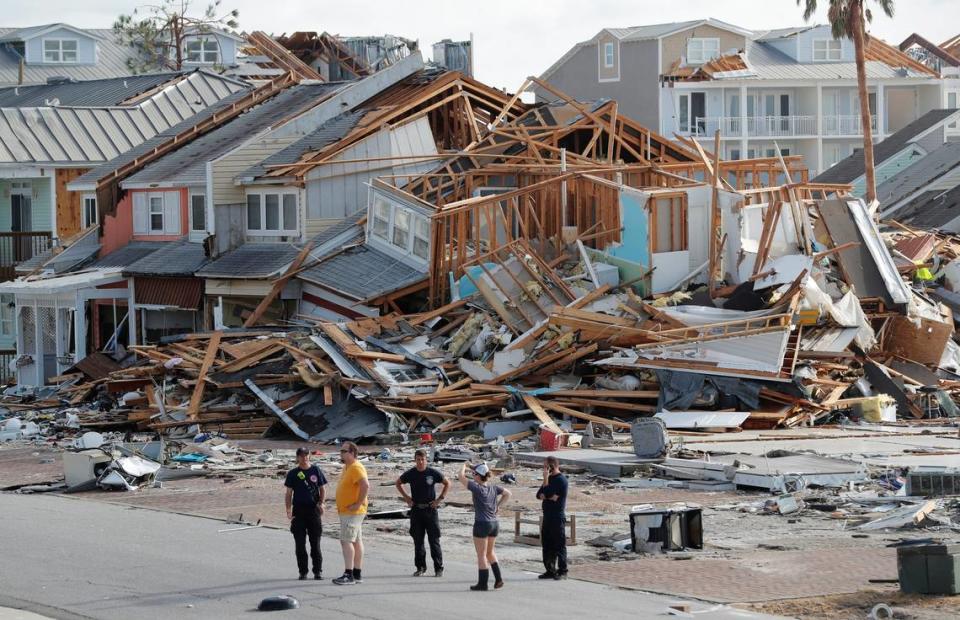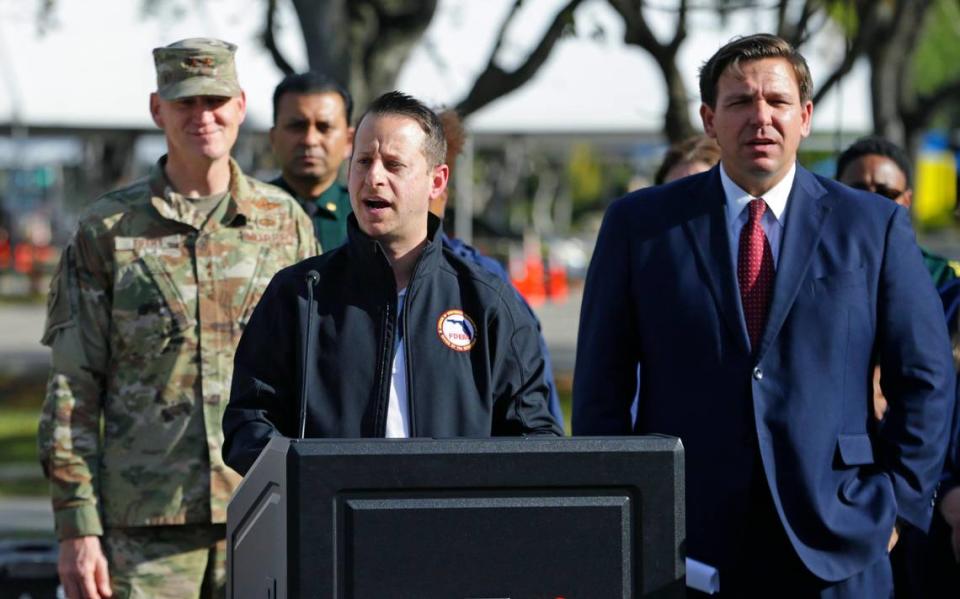Coronavirus could create ‘compound disaster’ in Florida as hurricane season looms
Florida emergency managers are accustomed to planning for hurricanes. But as the June 1 start of the season grows closer and the state’s coronavirus outbreak lingers on, questions and uncertainties are nagging at the people preparing for the worst-case scenario.
Will a stretched-thin FEMA be ready to respond? What will shelters look like in the age of social distancing? And if shelters open ahead of a hurricane, will vulnerable people leave their homes?
“The biggest issue we’re facing is the sheltering of people in cramped-in areas,” said Frank Rollason, the director of emergency management for Miami-Dade County. “We’ve told people to stay away from each other for so long that if a hurricane comes and we need to open shelters, we’re fearful that they won’t come.”
Florida’s U.S. senators called on the federal government Wednesday to issue guidelines on how states should handle evacuations and storm shelters in the event of a hurricane. And with less than two months to go until the tropics reach the conditions that forecasters expect will generate an above-average storm season, government officials and local politicians are hustling to prepare for what Broward County Mayor Dale Holness described as a “double disaster” of a hurricane strike amid a COVID-19 outbreak.
Listen to today's top stories from the Miami Herald:
Under normal conditions, preparing for a major storm — forecasters expect there will be four hurricanes this year that are Category 3 or stronger — is complicated, requiring planning for shelters, food, energy, potable water and disaster cleanup. But a coast-to-coast coronavirus outbreak is exacerbating that effort by stressing the Federal Emergency Management Agency, forcing the local agencies that respond to hurricanes into early action, and complicating the ability to pack thousands of people into the public schools that routinely serve as storm shelters.
“We know how to handle hurricanes,” Holness told the Miami Herald. “It’s this virus that’s devastating.”
Florida has been hit or narrowly edged by major storms in each of the past four years, including a direct hit to the Panhandle by Category 5 Hurricane Michael. And though state and local planners have for weeks been quietly studying how to navigate storm season amid a pandemic, Florida’s U.S. senators sent a letter to FEMA Director Peter Gaynor asking him to issue guidance to state and local governments about how they should prepare for a hurricane while social distancing measures are in place.

“With hurricanes, early planning and preparation is key, and while officials are currently focused on the pandemic, we must start thinking about June 1,” Sens. Marco Rubio and Rick Scott, both Republicans, wrote in a letter. “We ask that you take into account how to properly evacuate and shelter those who either have, or are suspected to have, the coronavirus in the event of a storm. Consistent and sound guidance will be crucial to saving lives during a natural disaster.”
Jared Moskowitz, director of the Florida Division of Emergency Management, said in an interview that he designated a team a month ago — as the coronavirus epidemic began to explode in Florida — to work on hurricane preparations. He said one of the key discussions ongoing with local governments is how to open school shelters should coronavirus continue to be a problem into the summer.
He said precautions could involve taking temperatures or administering COVID-19 rapid tests before people are admitted.
It’s unclear how long the ongoing COVID-19 outbreak — which has killed more than 370 people in the state — will remain a problem in Florida, or how long social distancing measures will need to take place. Health experts have warned that even if it tails off, the coronavirus could see a resurgence in the fall, when storms tend to form in the Caribbean.

In Miami-Dade County, Rollason said his office is looking at creating more space for people who show up at shelters. Normally, he said maximum occupancy is set to give everyone 20 square feet of space. He said the county now wants to make sure everyone at a public shelter gets 36 square feet of space — in case social distancing is still the rule.
That’s easier to do if a storm sideswipes the county, requiring fewer evacuations, he said. But if Miami-Dade is forced to order widespread evacuations, as it did ahead of Hurricane Irma in 2017, he said the school district plans to expand capacity by opening up classrooms that have been deep cleaned and left free of furniture.
The county is also exploring renting hotel rooms in bulk. “We’re going to pursue that because that’s the only option we have left to us,” Rollason said.
Other unknowns are keeping experts and first responders up at night.
Martha Baker, a registered nurse and president of SEIU Local 1991, which represents healthcare workers, said Jackson Memorial Hospital, Miami’s largest, would be stressed by a major storm if it is still dealing with COVID-19.
“Typically, other hospitals bring their patients to Jackson during a hurricane,” Baker said. “It would be stress on top of stress if we had a hurricane in June or July, but at Jackson we’ve had that drill down forever. Hopefully the timing is such that the two don’t collide.”
Richard Olson, the Extreme Events Institute director at Florida International University, said the possibility of a major hurricane making landfall during a pandemic creates a “potential compound disaster.” He questioned how states would handle a mass exodus from a neighboring state given worries about the spread of the virus, and questioned whether FEMA would struggle to respond to a storm after its resources have been stretched thin by an unprecedented national response to the COVID-19 pandemic.
“FEMA has never been mobilized for a pandemic before,” Olson said. “This is new and uncharted territory for them, but they’re responding. My concern comes from the what-if of a major hurricane while a pandemic is ongoing. How does an organization like FEMA respond to a compound disaster that is first nationwide and then likely to be an Atlantic Coast or Gulf Coast event? It is a scenario that wakes me up at night.”
The New York Times reported this week that the coronavirus pandemic has forced FEMA to suspend a recruiting effort and reduced the number of available personnel qualified to lead field operations. But local emergency managers who spoke to the Miami Herald said they remain confident in the agency’s ability to respond quickly if needed. And a FEMA spokesperson said Thursday that the agency is preparing for the possibility that its staff may be forced to respond to multiple disasters.
Moskowitz, the state emergency director, is also concerned about what he can’t control: the economy. He said the longer the economy remains stalled, the higher the unemployment rate will be, and the harder it will be for people to fend for themselves and stock up on hurricane supplies or generator fuel should a hurricane hit. More than 500,000 Floridians are out of work.
“Hurricane preparedness won’t just be affected by COVID-19. It will be dramatically affected by the economy,” said Moskowitz, whose staff is running estimates on how relief might need to be changed depending on the unemployment rate. “The amount of people who might need help after a hurricane would be dramatically impacted based on where we are in the economy.”
Moskowitz also frets that cash-strapped local governments will have to seek loans to respond initially to the destruction wrought by a storm, given that FEMA’s responsibilities largely lie in reimbursing expenses months after the fact. In the Florida Keys, which is still recovering from Hurricane Irma, which hit the lower end of the island chain as a powerful Category 4 storm in September 2017, Village of Islamorada Mayor Mike Forster is worried as revenue that should be flowing in during the tail end of the busy winter tourist season is quickly drying up because of the ban on visitors.
“While we have built up our reserves substantially during the last budget cycle, we still are not at the levels pre-Irma,” he said. “Nor, have we been made whole by FEMA.”
Shannon Weiner, director of Monroe County’s Emergency Management, said her department will start hurricane preparedness messaging in May, as it does every year. The governor’s May 17 hurricane conference was canceled. But in late May and early June, Emergency Management will begin storm season training and exercises, she said.
If anything, Forster, the mayor of Islamorada, said he hopes the pandemic has made the Keys readier to prepare for the hardships of a bad hurricane season.
“When we get through this pandemic, we will be able to get through whatever is thrown our way,” he said.

